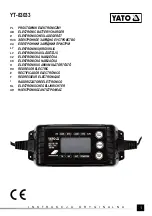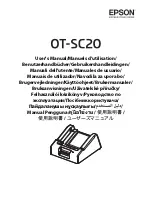
Switch
position
Suggested
battery type
Absorption
voltage* (V)
Float
voltage*
(V)
Equalize**
voltage* (V)
Equalize**
nominal
current
percentage
Temperature
compensation
factor* (mV/°C)
7
Lithium Iron
Phosphate
(LiFePo4)
batteries
14.2
28.4
56.8
13.5
27.0
54
n/a
n/a
0
0
0
* The top value is for 12V systems, the middle for 24V systems and the bottom for 48V systems.
** Equalize is by default disabled. To enable see chapter
A binary LED code helps determining the position of the rotary switch. After changing the position of the rotary switch, the LEDs
will blink during 4 seconds as indicated in below table. Thereafter, normal indication resumes, as described in the LEDs section.
Switch position
Bulk LED
Absorption LED
Float LED
Blinking frequency
0
1
1
1
Fast
1
0
0
1
Slow
2
0
1
0
Slow
3
0
1
1
Slow
4
1
0
0
Slow
5
1
0
1
Slow
6
1
1
0
Slow
7
1
1
1
Slow
5.1.3. Settings via the SmartSolar Control display
The SmartSolar Control display can be used to configure solar charger settings. For information how to do this see the
SmartSolar Control display manual
.
The SmartSolar display
5.1.4. Settings via MPPT Control display
The MPPT Control display can be used to configure solar charger settings, with the exception of advanced settings such as RX
and TX port settings. For information how to do this see the
The MPPT Control display
Although the MPPT Control display can connect to the solar charger, consider using a SmartSolar control
display instead.
5.2. All settings explained
This chapter lists all solar charger settings that are user-configurable and also explains how to update firmware of the solar
charger.
MPPT solar charger manual
Page 17
Configuration and settings
















































